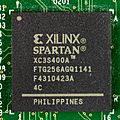Field-programmable gate array facts for kids
A Field-programmable gate array (often called an FPGA) is a special kind of electronic chip. Think of it like a blank canvas for digital circuits. Unlike most computer chips that are made to do one specific job, an FPGA can be programmed over and over again to do many different things. This makes them very flexible!
FPGAs are part of a group called programmable logic devices (PLDs). They are known for being very powerful and adaptable, but they can also be more expensive than other PLDs. One important thing about FPGAs is that they don't remember their programming when the power is turned off. So, they need a separate memory chip to store their instructions. When the FPGA turns on, it quickly reads these instructions from the memory chip, and then it's ready to work.
An FPGA is different from a microprocessor or microcontroller, which are chips that run software. An FPGA usually can't run software by itself. However, you can program an FPGA to act like a processor, and then it can run software!
Companies that make FPGAs also provide special computer programs. These programs let engineers design what the FPGA should do. The designs are often written using special computer languages called Hardware Description Languages (HDLs), like VHDL or Verilog. These languages look a bit like programming languages, but instead of writing software, you're describing how electronic circuits should work.
The FPGA design software takes the HDL code and turns it into instructions for the FPGA's tiny parts. This process is called "logic synthesis." Then, the software figures out the best way to arrange these parts on the chip. The final result is a "bitfile," which is like a blueprint that can be loaded onto the FPGA. This is usually done using a USB cable connected to a special port on the FPGA.
Because FPGAs are complex chips, manufacturers can add other useful parts directly onto them. These built-in parts are called "cores." For example, an FPGA might have a built-in Ethernet controller (for network connections) or even a complete processor. Manufacturers choose which cores to add based on what different industries need, like defense, medical devices, or robotics.
How FPGAs Work Inside
FPGAs are built from many small, programmable parts called logic elements, and ways to connect them. One key part of a logic element is a Lookup Table (LUT). Imagine a LUT as a tiny table that can be set up to give a specific output for any given input.
For example, a LUT with two inputs and one output can be programmed to act like an "AND" gate, an "OR" gate, or many other basic logic functions. The output of this LUT can either be saved in a small memory spot called a register or connected to other LUTs. A programmable mux (a kind of switch) lets the FPGA choose if it uses the saved output or the direct output. This combination of a LUT, a register, and a mux forms the basic building block of an FPGA.
To connect these logic elements, FPGAs use tiny switches called "pass transistors." These transistors can be programmed to either connect two wires or keep them separate. This allows the FPGA to precisely link different logic elements together. For instance, if the output of one logic element needs to go into another, the pass transistor can be programmed to make that connection. Special software then takes the design you create and uses these pass transistors to connect all the logic elements correctly.
Images for kids
-
Simplified example illustration of a logic cell (LUT – Lookup table, FA – Full adder, DFF – D-type flip-flop)
See also
 In Spanish: Matriz de puerta programable en campo para niños
In Spanish: Matriz de puerta programable en campo para niños





